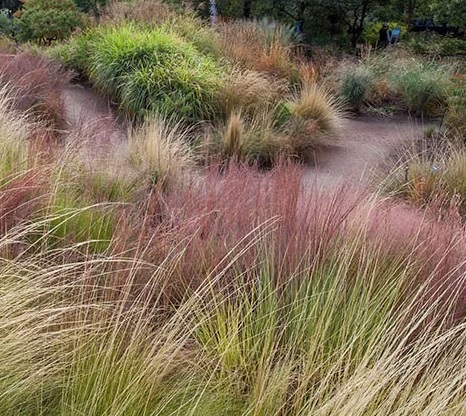
ORNAMENTAL GRASSES

One of the toughest and most versatile groups of perennials is the ornamental grasses. Whether sunny or shady, wet or dry, windy or calm site and you need a grass within a certain height range, there will be a one for your needs. Grasses help soften the landscape among the bolder foliage of the woody shrubs as they gently sway in any whisper of wind. Most are attractive through winter, brightening any landscape at a time we need it the most.
Growth Habits
Growth habits of grasses need to be considered when choosing one for your yard. There are spreading varieties ideal for groundcover in tough-to-mow areas. Most are clump forming and will stay where you plant them, although the clumps can become quite large on some varieties. Some are low and tufted, others tall and arching or mid-sized and upright. Look at the spot you want to plant and think about how you want them to look. Think overall height and spread, green or variegated, upright and vertical or upright and arching.
Planting
Ornamental grasses prefer being planted between April and early October. This will give them time to establish their roots and settle in for winter. Most prefer a sunny spot. Only a few will thrive in shade. The sunny grasses will tolerate some shade, but you will sacrifice overall height and spread. Too deep of a shade and grasses will become weak and floppy. They will not compete well with larger tree roots in the vicinity unless additional water is applied during the growing season.
Fertilization
Keeping fertility levels low will prevent grasses from becoming floppy. An application of Holly-Tone early in the spring should be all they need to keep them healthy throughout the season. If at some point you notice your grasses becoming pale or off color, please ask for advice before giving them more fertilizer. While there are few problems the grasses can have it is better to check with the garden center before jumping in with more fertilizer.
Watering
The first year your grasses are planted, water as needed. Do not allow them to go long periods without water. The second year they should do fine on their own. Over watering of some grasses will cause them to become floppy or even to rot. Carex and Miscanthus varieties do not mind a little extra water and are wonderful for damp areas.
Winter Care
Most grasses may be left standing for the winter, providing interest at a time we need it the most. The wildlife in your area will also appreciate the foliage to hide in and the seeds to feed on. Most need to be cut back late in the winter before spring growth begins. The grasses begin new growth from the roots and the dead foliage needs to be removed to make room for the new. If you do not remove the dead leaves, they will be there among the live foliage that summer, making the entire grass plant unattractive.
The easiest way to cut down the tall grasses is to tie them up with string (to hold the foliage together) and cut along the base with electric hedge shears. If you are too far away from an electrical source, long handled loppers work best. Although tedious and difficult, hand pruners will also work.
Following is a list to begin choosing the grass that is right for you. They are listed by height to narrow the field a bit further. Remember to keep in mind growth habit, sun or shade, green or variegated and how it will flow into the rest of the landscape in that area.
6-12”
Carex m.’ Ice Dance” – Variegated Sedge – 12”
Carex o. ‘Evergold’ – Variegated Sedge – 12”
Carex glauca – Blue Sedge – 8”
Carex f. ‘Blue Zinger’ – Blue Sedge – 12”
Festuca g. ‘Elijah Blue’ – Blue Fescue – 10”
Festuca g. ‘BoulderBlue’ – Blue Fescue – 10”
Liriope s. ‘Silver Dragon’ – Variegated Lilyturf – 10”
Liriope s. ‘Majestic Blue’ – Green Lilyturf – 10”
Ophiopogon p. ‘Ebony Knight’ – Black Mondo Grass – 6”
Pennisetum a. ‘Little Bunny’ – Little Bunny Fountain Grass – 10”
12 – 24”
Calamagrostis brachytricta – Korean Feather Reed Grass – 24”
Hakonechloa m.aureola – Variegated Japanese Forest Grass – 15-18”
Imperata c. ‘Red Baron’ – Japanese Blood Grass – 12-18”
Miscanthus s. ‘Little Kitten’ – Dwarf Maiden Grass – 18-24”
Pennisetum a.Hameln– Dwarf Fountain Grass – 24-30”
Phalaris a. ‘Feesey’s Form’ – Variegated Ribbon Grass – 18-24”
24” – 36”
Chasmanthium l.– Northern Sea Oats – 30-36”Calamagrostis a. ‘Overdam’ – Variegated Feather Reed Grass – 24-30”
Helichtotrichon s. ‘Sapphire’ – Blue Oat Grass – 24-30”
Pennisetum a. – ‘Moudry” – Black Fountain Grass – 24-30”
36” – 48”
Calamagrostis a. ‘Karl Forester’ – Feather Reed Grass – 3-4’
Calamagrostis a. ‘Avalanche’ – Variegated Feather Reed Grass – 4’
Miscanthus s. ‘Adagio’ – Dwarf Maiden Grass – 36”
Miscanthus purpurascens – Flame Grass – 3-4’
Panicum v. ‘Shenendoah’ – Shenendoah Switch Grass – 3-4’
Pennisetum a. – Fountain Grass – 4’
Pennisetum a. – Giant Fountain Grass – 4-5’
48” and larger
Miscanthus s. ‘Blutenwunder’ – Blooming Wonder Maiden Grass – 5-6’
Miscanthus s. ‘Morning Light’ – Silver Maiden Grass – 5’
Miscanthus giganeus – Giant Chinese Silver Grass – 10-14’
Miscanthus s. ‘Gracillimus’ – Graceful Maiden Grass – 6-7’
Miscanthus s. ‘Graziella’ – Graziella Maiden Grass – 5-6’
Miscanthus s. ‘Malepartus’ – Malepartus Maiden Grass – 5-6’
Miscanthus s. ‘Silberfeder’ – Silver Feather Maiden Grass – 6-7’
Miscanthus s. strictus – Porcupine Grass – 6-7’
Miscanthus s. variegates – Striped Maiden Grass – 5-6’
Miscanthus s. zebrinus – Zebra Grass – 6-7’
Panicum v. “Heavy Metal’ – Heavy Metal Switch Grass – 4-5’
Panicum v. Cloud Nine – Cloud Nine Switch Grass – 5-6’
Panicum v. ‘DallasBlues –DallasBlues Switch Grass – 5’
Panicum v. ‘Rotstrahlbusch’ – Red Switch Grass – 4’
Panicum v. ‘Northwind” – Upright Switch Grass – 6’
Saccharum ravennea – Ravenna Grass – 10-12’
*A note
Many folks come to us asking for a “pampas grass”. The true Pampas Grass is a southern grass variety that is not hardy to our zone. (5B). While it may be grown as a novelty in a protected area in the yard, its hardiness is not reliable.
What many are calling “pampas grass”, when they see them around town, is probably one of the many Miscanthus types that are very hardy, and can be seen growing everywhere in Montgomery County.

